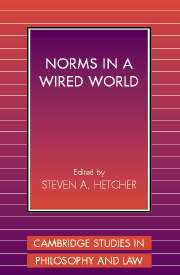Book contents
- Frontmatter
- Contents
- Acknowledgments
- Introduction
- PART I THE PATTERN CONCEPTION OF NORMS
- PART II NEGLIGENT NORMS
- 6 The Traditional Rule of Custom
- 7 The Evidentiary Rule of Custom
- 8 A World of Dangerous Norms and Customs
- 9 Regulating the Rule of Custom to Create Safe Social Norms
- 10 Juror Norms and the Reasonable Person Standard
- 11 Rejection of the Dominant Paradigm of Negligence
- PART III CYBERSPACE PRIVACY NORMS
- Conclusion
- Notes
- Index
6 - The Traditional Rule of Custom
Published online by Cambridge University Press: 05 June 2012
- Frontmatter
- Contents
- Acknowledgments
- Introduction
- PART I THE PATTERN CONCEPTION OF NORMS
- PART II NEGLIGENT NORMS
- 6 The Traditional Rule of Custom
- 7 The Evidentiary Rule of Custom
- 8 A World of Dangerous Norms and Customs
- 9 Regulating the Rule of Custom to Create Safe Social Norms
- 10 Juror Norms and the Reasonable Person Standard
- 11 Rejection of the Dominant Paradigm of Negligence
- PART III CYBERSPACE PRIVACY NORMS
- Conclusion
- Notes
- Index
Summary
In country life a multitude of acts are habitually committed that are technically trespasses. Persons walk, catch fish, pick berries, and gather nuts in alieno solo without strict right. Good-natured owners tolerate these practices until they become annoying or injurious, and then put a stop to them. Little practical inconvenience results from the state of things, which the courts may well leave to regulate itself.
Albright v. CortlandIntroduction
Part One developed the pattern conception of social norms. Part Two will apply this framework in the context of tort law. This application will test the value of the pattern conception; the more it illuminates tort law, the more valuable it is proven to be. As discussed in the book's Introduction, tort law is at the core of a liberal theory of social order. Liberalism begins with a brute conception of the intrinsic moral worth of the individual. From this starting point, the theory of human rights and personal autonomy follow. Free people may do as they please, so long as others are not injured in the process. When others are injured, however, tort lawmay be implicated. As Part One indicated, free people characteristically choose to conform to social norms. When they do, and when others are injured in the process, meaningful solutions must take place at the intersection of norms and torts.
The present chapter begins the examination of the role of social norms in tort law. The focus in this chapter is on the historical development of the concept of legally valid custom, or what is sometimes referred to as the rule of custom.
- Type
- Chapter
- Information
- Norms in a Wired World , pp. 149 - 162Publisher: Cambridge University PressPrint publication year: 2004

